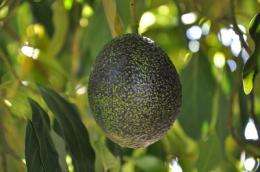'GEM' avocado
The University of California, Riverside, has signed an exclusive license agreement with Westfalia Fruit Estates, a South African company, to market ‘GEM,' an avocado variety developed by UC Riverside researchers.
According to the agreement signed last month, Westfalia will be UC Riverside's primary licensee for ‘GEM' around the world. Currently, in the United States, the California-based Brokaw Nursery has non-exclusive rights to the ‘GEM' avocado.
"UC Riverside's Office of Technology Commercialization continues to seek out the best partnerships worldwide for the commercialization of citrus and other agriculture varieties developed at our campus," said Craig Sheward, assistant vice chancellor for technology commercialization at UC Riverside. "Westfalia is a leading multinational avocado supplier and a worldwide leader in avocado research, marketing, processing, production and commercialization. It will be through the future successful efforts of Westfalia that UCR's avocado varieties will have an impact on the worldwide avocado market."
Named after the initials of researcher Grey E. Martin, who selected the variety, ‘GEM' fruit are produced on a semi-compact, vase-shaped tree. The fruit's skin color turns from green (when on the tree) to a dark burgundy/black when ready to eat. The tear-drop shaped fruit are borne typically interior in the tree, mostly in clusters, thus protecting the fruit from the elements. The trees also are less prone to severe "alternate bearing" (abundant fruit one year followed by few fruit the next year) than ‘Hass,' currently the dominant variety in the commercial trade.
The ‘GEM' variety can grow anywhere in the world where growing conditions are similar to Southern California's (San Diego-San Luis Obispo Counties). The seasonality of ‘GEM' is somewhat later than that of ‘Hass,' allowing for a later start of harvesting and subsequently a later marketing window. In California, the fruit will hang on the tree very well into August and early September. In cooler places, like coastal Santa Barbara, it can hang on the tree until October.
"The ‘GEM' avocado variety's attractive look and high quality are what got Westfalia interested in the fruit," said Stefan Köhne, the research and development manager for Westfalia. "This is a variety which, under South African conditions, matures a few weeks later than the ‘Hass' variety. Westfalia is particularly encouraged by the positive outcome of independent taste panels conducted in the United Kingdom, where ‘GEM' scored better than late season ‘Hass' in terms of eating quality. ‘GEM' trees also lend themselves to being planted in higher densities, and the compactness of the tree will allow for easier management of the trees. The ‘GEM' variety is starting to distinguish itself not only as a superior high quality fruit for the customer but also an attractive cultivar for the grower to produce and manage."
UC Riverside has developed other avocado varieties before ‘GEM': ‘Gwen,' ‘Whitsell' and ‘Esther' were released in the early 1980s; ‘SirPrize' and ‘Lamb Hass' in the mid-1990s; and ‘Harvest' in the 2000s.
"Avocados are always a challenge since the selection rate for promising material is about one to two selections per 1,000 seeds planted," said UC Riverside's Mary Lu Arpaia, a cooperative extension subtropical horticulturalist, who leads the current program searching for new varieties. "The ‘GEM' variety arose from a mass planting of seedlings planted in the late 1980s. This selection is a seedling of the ‘Gwen' variety."
In South Africa, Westfalia plans to market ‘GEM' towards the end of the traditional avocado harvesting season. The company will market ‘GEM' almost exclusively through Woolworths, a leading high-end retail chain store in South Africa. Outside South Africa, the company will market the fruit, as a pre-ripened avocado of superior eating quality, primarily through high-end retail chain stores. Westfalia also plans to contract ‘GEM' growers and marketers in Australia, Brazil, Chile, Colombia, the European Union, Israel, Morocco, New Zealand, Peru and countries in sub-Saharan Africa to ensure fruit availability year-round.
Provided by University of California, Riverside























